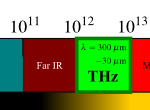The Terahertz laboratories are actively involved in creating new emitters and detection techniques at terahertz frequencies.
Optical Gating of Graphene
We demonstrate experimentally nonvolatile, all-optical control of graphene’s charge transport properties by virtue of an Fe:LiNbO3 photoconductive substrate. The substrate can register and sustain photoinduced charge distributions which modify locally the electrostatic environment of the graphene monolayer and allow spatial control of graphene resistivity.
see publication
https://pubs.acs.org/doi/10.1021/acsnano.8b02161
Novel emitters
Research involving the creation of new THz antennas, particularly antennas that do not require electrical bias signal. Currently, the group is focussing on antennas that utilise the lateral photo-Dember effect, where the diffusion of photo-excited carriers is responsible for the emitted THz waves.


